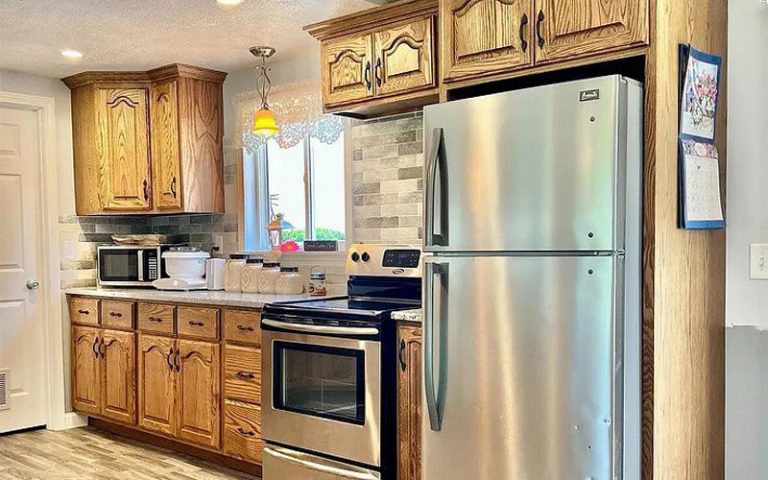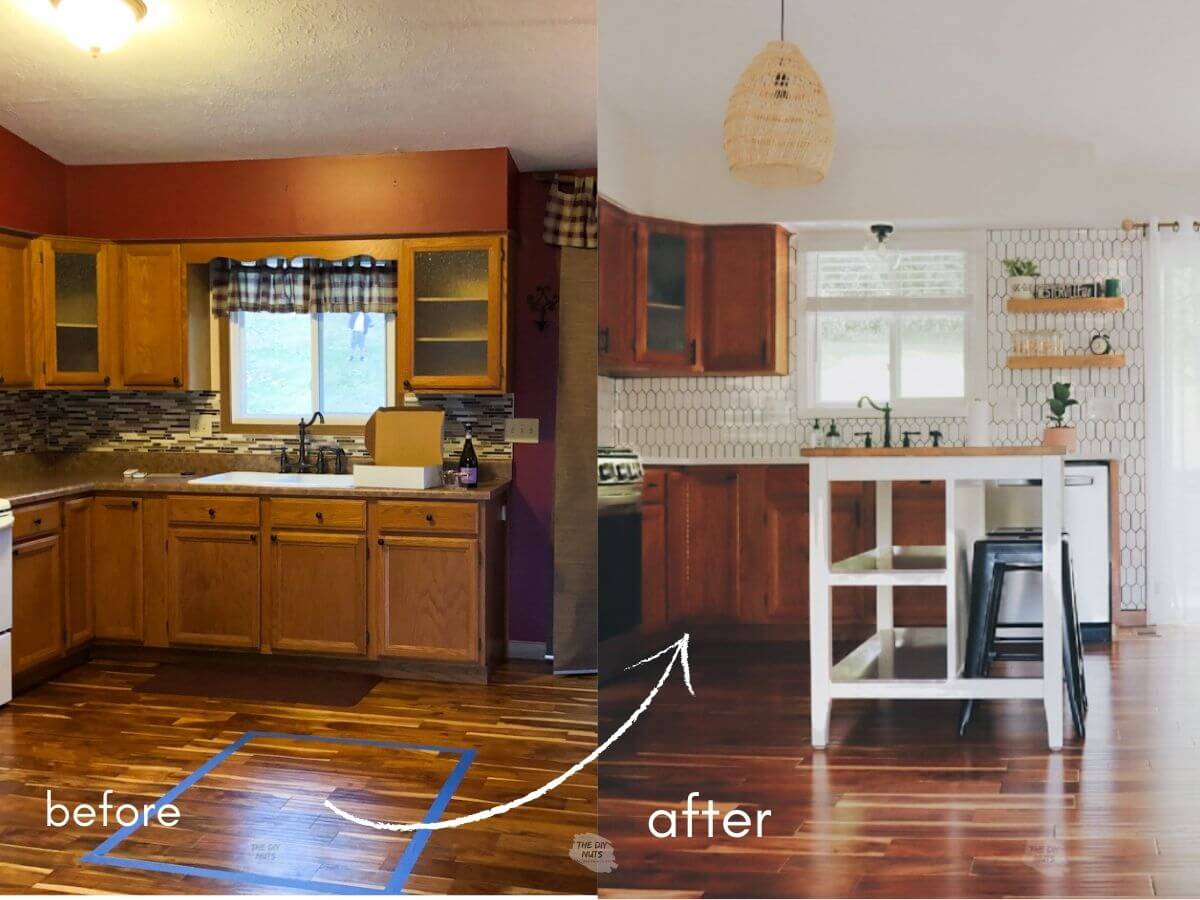The Importance of Refinishing Mobile Home Cabinets

Refinishing mobile home cabinets is a simple yet transformative project that can significantly enhance the look, functionality, and overall value of your home. Beyond mere aesthetics, this task addresses several practical concerns that often plague mobile home interiors. Outdated cabinets, marred by wear and tear, can detract from the overall appeal of your home, while refinishing breathes new life into these spaces, creating a more inviting and modern environment.
Aesthetics and Curb Appeal
Refinishing mobile home cabinets plays a crucial role in enhancing the aesthetics of your home’s interior. Outdated cabinets, often characterized by faded finishes, chipped paint, and outdated designs, can significantly diminish the overall appeal of your living space. A fresh coat of paint, a change in hardware, or a complete makeover with new doors and drawer fronts can dramatically transform the look and feel of your kitchen, bathroom, or any other room with cabinetry. This transformation not only enhances your enjoyment of the space but also contributes to a more positive impression for potential buyers should you decide to sell your mobile home in the future.
- Increased Visual Appeal: A fresh coat of paint or a new finish can instantly revitalize tired-looking cabinets, making them appear more modern and stylish. This can dramatically improve the overall visual appeal of your mobile home’s interior.
- Harmonious Interior Design: Refinishing cabinets allows you to match the color and style of your cabinets to the rest of your décor, creating a more cohesive and harmonious interior design. This can elevate the overall look and feel of your home.
- Enhanced Curb Appeal: While not directly visible from the exterior, a beautifully refinished interior, including the cabinets, contributes to the overall impression of your home. A well-maintained interior often translates to a more positive perception of the home’s condition and value, boosting curb appeal.
Choosing the Right Refinishing Method

Refinishing mobile home cabinets can dramatically improve their appearance and overall value. The choice of refinishing method depends on factors like the existing condition of the cabinets, the desired aesthetic, and your budget. This section will compare and contrast popular refinishing methods, highlighting their pros and cons.
Painting
Painting is the most versatile and accessible refinishing method, offering a wide range of colors and finishes. It is also relatively inexpensive and can be done by most homeowners with basic DIY skills.
Pros
- Versatility: Painting allows for a wide range of color choices and finishes, from glossy to matte, to match any decor.
- Cost-effective: Paint is generally less expensive than other refinishing materials like stain or cabinet paper.
- Easy application: Painting is relatively easy to apply, making it a suitable choice for DIY projects.
- Excellent for hiding imperfections: Paint can effectively cover scratches, dents, and other imperfections on cabinet surfaces.
Cons
- Less durable than stain: Paint can be more prone to chipping and scratches, especially in high-traffic areas.
- Requires proper preparation: Before painting, surfaces must be properly cleaned, sanded, and primed to ensure a smooth and long-lasting finish.
- May require multiple coats: Depending on the desired opacity and coverage, multiple coats of paint may be necessary.
Staining
Staining is a popular choice for refinishing cabinets, as it enhances the natural wood grain and creates a warm, elegant look. Staining is generally more durable than painting and can provide a rich, lasting finish.
Pros
- Durability: Staining creates a more durable finish than paint, resisting scratches and chips better.
- Enhances natural wood grain: Stain allows the natural beauty of the wood grain to shine through, creating a unique and elegant look.
- Wide range of colors and finishes: Stains are available in a wide variety of colors and finishes, from light and natural to dark and rich.
Cons
- More expensive than paint: Staining can be more expensive than painting, especially if you choose a high-quality stain.
- Requires more skill and precision: Staining requires more skill and precision than painting to achieve a uniform and even finish.
- Not as forgiving as paint: Staining can be more difficult to correct mistakes, as it penetrates the wood and can be difficult to remove.
Cabinet Paper
Cabinet paper, also known as contact paper, is a self-adhesive paper that can be applied to cabinet surfaces to create a new look. It is a relatively inexpensive and easy-to-apply option, but it is not as durable as painting or staining.
Pros
- Inexpensive: Cabinet paper is a very affordable refinishing option, making it a great choice for budget-conscious homeowners.
- Easy application: Cabinet paper is easy to apply, making it a suitable choice for DIY projects.
- Wide variety of patterns and colors: Cabinet paper is available in a wide variety of patterns and colors, allowing for creative and unique designs.
Cons
- Less durable than paint or stain: Cabinet paper is not as durable as paint or stain and can be prone to peeling or tearing, especially in high-traffic areas.
- May not be suitable for all cabinets: Cabinet paper may not be suitable for cabinets with heavily damaged surfaces or those exposed to high levels of moisture.
- Can be difficult to remove: Removing cabinet paper can be difficult and may damage the underlying surface.
Step-by-Step Refinishing Guide: Refinishing Mobile Home Cabinets

Refinishing mobile home cabinets is a rewarding project that can significantly enhance the look and feel of your living space. By following this comprehensive guide, you’ll be equipped to transform your cabinets from outdated to stunning.
Preparing the Cabinets
Preparing the cabinets is crucial for a successful refinishing project. Proper preparation ensures a smooth, even finish and prevents imperfections from showing through.
- Remove Cabinet Doors and Hardware: Begin by removing all cabinet doors and hardware, including hinges, knobs, and pulls. This allows for easier access and prevents damage during the refinishing process.
- Clean the Surfaces: Thoroughly clean the cabinet surfaces with a degreaser and a soft cloth. This removes dirt, grease, and any residue that may interfere with the adhesion of the new finish.
- Sand the Surfaces: Sand the cabinet surfaces with progressively finer grit sandpaper to create a smooth, even surface. Start with 80-grit sandpaper to remove any imperfections, then move to 120-grit and finally 220-grit for a fine finish. For a professional touch, use a sanding block to ensure even pressure and prevent sanding marks.
- Fill Any Cracks or Holes: Use wood filler to fill any cracks, holes, or imperfections. Allow the filler to dry completely before sanding it smooth.
- Prime the Surfaces: Apply a primer to the cabinet surfaces, ensuring complete coverage. A primer helps to create a uniform surface for the paint or stain and improves adhesion. Allow the primer to dry thoroughly before proceeding to the next step.
Applying the Finish, Refinishing mobile home cabinets
Applying the finish is the most visually impactful step in the refinishing process. This step involves selecting the right finish and applying it evenly to achieve the desired look.
- Choose the Finish: Decide whether you want to paint or stain your cabinets. Painting provides a solid color and offers a wide range of options, while staining enhances the natural wood grain and adds warmth to the space.
- Apply Paint or Stain: If painting, use a high-quality paint specifically designed for cabinets. Apply the paint in thin, even coats, allowing each coat to dry completely before applying the next. For a smooth, professional finish, use a brush or roller for large areas and a small brush for corners and edges. If staining, apply the stain evenly with a brush or cloth, following the manufacturer’s instructions. Allow the stain to dry completely before applying a sealant.
- Apply a Topcoat: After the paint or stain has dried, apply a topcoat to protect the finish and enhance its durability. Choose a topcoat that is compatible with your chosen finish. For example, if you painted the cabinets, you can use a polyurethane or acrylic topcoat. If you stained the cabinets, you can use a polyurethane or wax topcoat.
Finishing Touches
Finishing touches add the final touches to your refinished cabinets, making them look professional and polished.
- Install Hardware: After the finish has completely dried, install the cabinet doors and hardware. Make sure the hardware is properly aligned and secured.
- Clean Up: Clean up any spills or drips immediately to prevent them from staining the finish.
Additional Tips and Tricks
- Work in a Well-Ventilated Area: When working with paint, stain, or other finishes, ensure you work in a well-ventilated area to avoid inhaling harmful fumes.
- Use Drop Cloths: Protect your floors and surrounding areas with drop cloths to prevent paint or stain spills.
- Wear Gloves and a Mask: Wear gloves to protect your hands from chemicals and a mask to protect your respiratory system from dust and fumes.
- Practice on Scrap Wood: Before applying paint or stain to your cabinets, practice on a scrap piece of wood to get a feel for the application process and ensure you are happy with the results.
- Take Your Time: Don’t rush the process. Allow each coat of paint or stain to dry completely before applying the next. This will help to ensure a smooth, even finish.
Professional Results
| Step | Description | Tips | Professional Results |
|---|---|---|---|
| 1. Preparation | Thorough cleaning, sanding, and priming are essential for a smooth, even finish. | Use a degreaser to remove dirt and grease. Sand with progressively finer grits for a smooth surface. Prime for better adhesion. | Imperfections are minimized, and the finish adheres well to the surface. |
| 2. Application | Apply paint or stain in thin, even coats, allowing each coat to dry completely. | Use a brush or roller for large areas and a small brush for corners. Apply stain evenly with a brush or cloth. | A smooth, even finish without streaks or drips. |
| 3. Finishing Touches | Install hardware, clean up any spills, and apply a topcoat for protection. | Align hardware properly and secure it firmly. Clean up spills immediately to prevent staining. | Professional-looking cabinets with a durable finish. |
Refinishing mobile home cabinets can be a transformative project, breathing new life into a space. If you’re looking for inspiration, consider the sleek and stylish james martin bathroom vanity cabinets as a guide. Their attention to detail and use of high-quality materials can be adapted to your own home renovation, adding a touch of elegance and sophistication to your mobile home’s interior.
Refinishing mobile home cabinets can be a rewarding project, transforming outdated spaces into modern havens. If you’re seeking inspiration for a fresh look, consider incorporating elements like a floating bathroom sink with cabinet for a sleek and minimalist aesthetic.
The clean lines and open space of a floating sink can translate beautifully to your cabinet refinishing project, adding a touch of contemporary elegance to your mobile home.
